Creative Color Combinations for Bedroom Walls and Ceilings
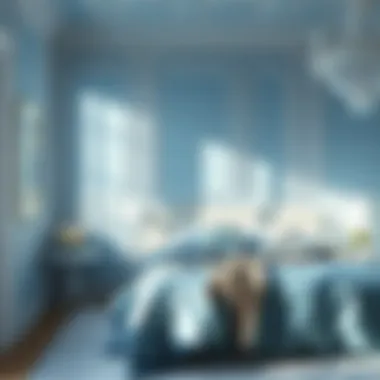
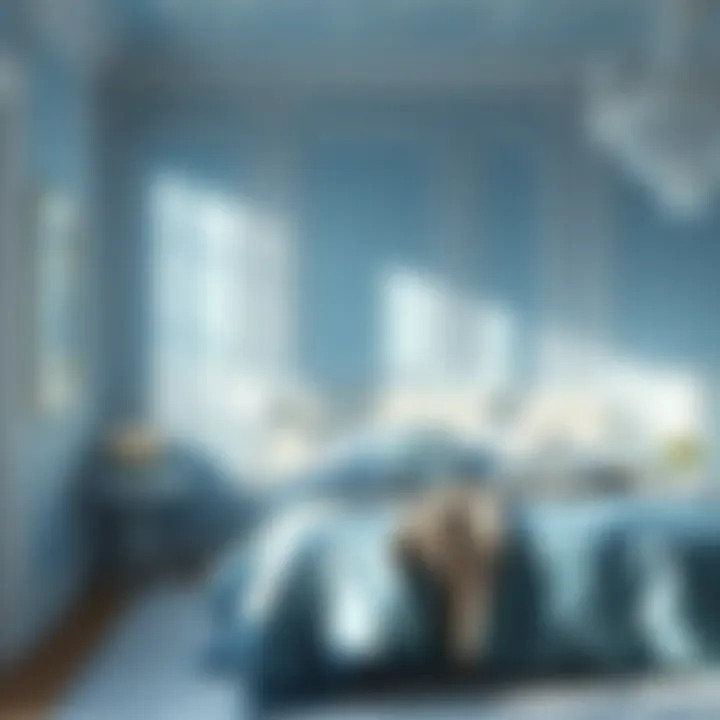
Intro
When it comes to creating a restful bedroom, the colors you choose play a crucial role in shaping an atmosphere conducive to tranquility and relaxation. Color combinations for walls and ceilings can elevate your space from ordinary to extraordinary, but it’s not just about picking your favorites; it’s about understanding the psychology of hues, the harmony of design, and the practical aspects of how colors interact with your space. This exploration aims to guide you in navigating these complexities, helping you create an inviting sanctuary tailored just for you.
While it may seem overwhelming at first, embarking on a journey through color combinations doesn’t have to be daunting. With the right approach, you’ll find that the process can be both insightful and rewarding. Let’s dive into some current trends that can inspire and inform your choices.
Current Trends
Staying ahead of the game when it comes to color can invigorate your space and reflect your personality. Below, we’ll explore some of the hottest trends making waves in bedroom design.
Color Palettes
The right color palette can set the tone for your entire bedroom.
- Soft Neutrals: Shades like beige, taupe, and ivory create a soothing backdrop. These colors help calm the mind and provide a perfect base for adding pops of color through accessories.
- Earthy Tones: Greens, terracottas, and browns are gaining traction as more folks gravitate toward nature-inspired aesthetics. These colors bring warmth and a feeling of connection to the great outdoors.
- Bold Accents: Incorporating bolder colors like deep navy or rich burgundy as accent walls can add depth without being overwhelmingly loud.
- Pastels: Soft pastels have made a comeback, giving a serene vibe that’s particularly desirable in a bedroom setting.
Popular Styles
As design preferences evolve, specific styles tend to dominate the market. Here are a few popular styles that reflect current tastes:
- Minimalist: Clean lines and simple color schemes. Often involves whites or soft grays paired with natural materials.
- Scandinavian: Known for its light and airy feel, this style often employs hues like pale blue or muted greens, alongside whites.
- Bohemian: This eclectic style embraces a mix of colors, often showcasing warm tones alongside rich jewel colors for a vibrant, personal touch.
Staying informed about current trends can significantly influence your choices, helping you cultivate a space that not only meets your aesthetic preferences but also connects with deeper emotional needs.
"Choosing the right color for your bedroom isn’t just about design; it’s about creating a space that reflects who you are and how you wish to feel."
Visual Ideas
A picture speaks a thousand words, so let’s look at some visual inspirations that can elevate your bedroom design:
Gallery of Styled Bedrooms
Imagine walking into a space where every color speaks to your soul. Look for designs showcasing a balance of colors that exude peace and style. For instance:
- A soft gray wall adorned with vibrant artwork.
- Earthy greens harmoniously paired with light wood furnishings.
Visual ideas help solidify your own inspiration while serving as a model for your project.
Before-and-After Transformations
Transforming a bedroom can showcase the dramatic effects of color combinations:
- A once stark white room can burst to life with pastel walls and colorful bedding, turning it into a refreshing retreat.
- Smoky blue walls bringing an air of sophistication while contrasting beautifully with lighter furniture choices in previously dull, sterile spaces.
Emphasizing the power of color in your bedroom design sets the tone. The right hues can shift moods, promote relaxation, and provide a canvas for personal expression.
Whether you’re gearing up for a complete overhaul or a simple refresh, understanding color combinations can significantly enhance your bedroom’s look and feel.
The Importance of Color in Bedroom Design
Color plays a pivotal role in how we perceive our environment, especially in spaces where we seek comfort and relaxation, such as our bedrooms. The hues that adorn the walls and ceilings can influence our mood, create a sense of ambiance, and reflect our personal style. Making thoughtful color choices is not just about aesthetics; it's about setting the tone for the experiences we have in these intimate spaces.
Creating Atmosphere through Color Choices
To create a specific atmosphere in a bedroom, one must first understand the emotional responses that different colors evoke. For instance, soft blues and greens may usher in tranquility and a sense of calm, perfect for winding down after a long day. Conversely, bold reds or deep purples might energize the space and incite passion or creativity.
When selecting colors, consider also how they interact with furnishings, decor, and even the architecture of the room. A sunny yellow can spark joy but might overwhelm in excessive amounts. A well-considered approach might involve painting an accent wall for a touch of vibrancy without fully committing to a loud color theme.
Using color to define zones within the bedroom is another effective strategy. For example, painting the wall behind a bed in a warm, rich shade can create a cozy, inviting atmosphere, while employing softer shades around a work nook can help with focus and concentration.
Understanding Color Psychology
Delving into the realm of color psychology is vital for anyone looking to transform their bedroom. This field explores how colors influence perceptions and behaviors, impacting our emotional and psychological states. For instance, warm tones like oranges and yellows are often associated with feelings of comfort and warmth, making them great for a space meant to feel inviting.
On the flip side, cooler colors like blues and greens tend to promote serenity, making them ideal for bedrooms where relaxation is a priority. It’s also worth noting that lighter colors can make a space feel bigger, which is useful in smaller rooms. The right color combination can therefore not only enhance the room's aesthetic but also improve the functionality and usability of the space.
"The use of color in bedroom design is more than just decoration; it's a psychological journey that affects daily living."
When considering a paint palette, think about how variations of the primary colors can create depth. For example, a soft sky blue can be paired with a muted navy for a harmonious look that offers both calmness and dimension. Ultimately, it's important to choose colors that resonate with you personally, reflecting your tastes and lifestyle.
Assessing Space Characteristics
When it comes to designing your bedroom, understanding space characteristics is like having a map in a foreign land. Each room tells a different story, shaped by its size and layout. Knowing how these elements influence your color choices can truly elevate your design game. This section emphasizes the importance of assessing room dimensions and the impact of natural light, both vital components that can make or break your color scheme decisions.
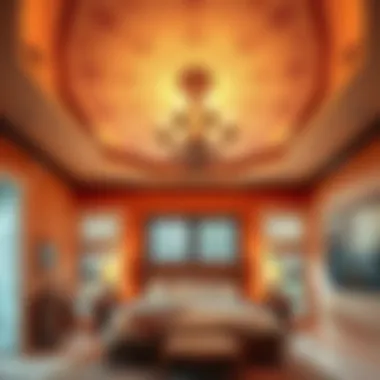
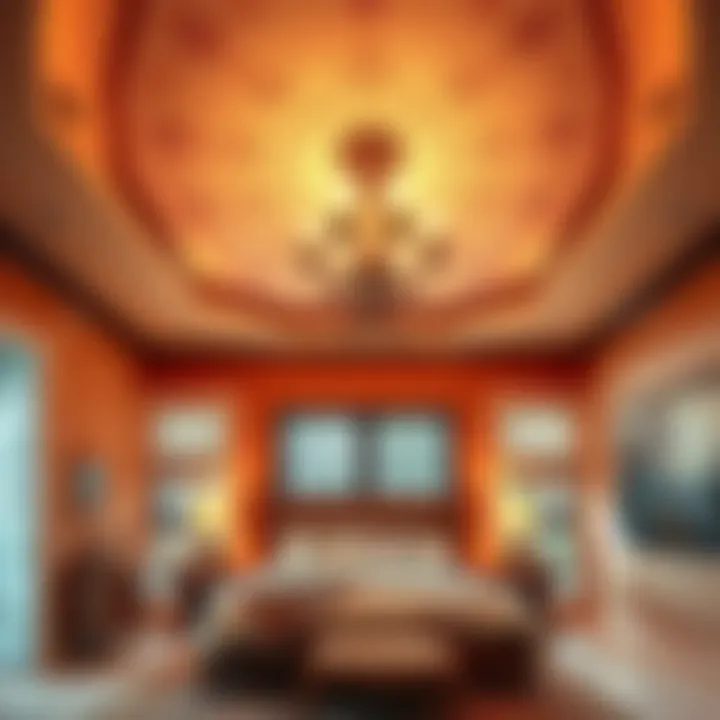
Evaluating Room Size and Layout
Room size can play a more significant role in color choice than one might initially think. A spacious bedroom often offers freedom to explore bolder hues, such as deep blues or rich reds. These colors can provide a sense of comfort and intimacy, making large spaces feel cohesive and inviting. On the other hand, when dealing with smaller rooms, lighter shades tend to open up the area, creating an illusion of space. Soft creams, pale greens, and crisp whites can expand the boundaries of a room, making it feel airy and expansive.
Consider the room's layout as well; irregular shapes might call for unique color accents to help visually balance the space. For instance, if one wall sticks out like a sore thumb, painting it a contrasting color can draw attention and balance the overall look. In contrast, a room with a more traditional rectangular layout may benefit from a single cohesive color palette that flows seamlessly from one wall to the next, creating a calming and unified atmosphere.
Here are a few points to consider when evaluating room size and layout:
- Larger rooms can handle darker or more vibrant colors, achieving a sense of warmth and comfort.
- Smaller rooms do better with lighter colors to maximize light and airflow.
- Unusual layouts can benefit from strategic color placement to direct the eye and balance the space.
The Role of Natural Light
Natural light is often an overlooked gem in the realm of interior design. It dramatically affects how color appears within a space. Rooms that are bathed in sunlight tend to enhance warmer colors, making them appear even more vibrant. However, if your bedroom only welcomes in the late afternoon sun, you might want to rethink using darker tones, as they can absorb too much light and risk making the space feel gloomy.
When assessing natural light, it’s crucial to observe how the sun moves throughout the day. For instance, east-facing rooms are kissed by soft morning light that gradually brightens, while west-facing ones receive warmer tones as the sun sets. You might find that colors that were once perceived during one time of day can change dramatically as the sun casts its glow.
Here are some thoughts to keep in mind regarding natural light:
- Always test paint samples in different lighting conditions. Room light can shift your perception of color.
- Consider sheer or light-filtering window treatments to maximize the benefits of natural light while still offering privacy.
- Cultivate a color palette that harmonizes with the amount of natural light in the room, ensuring a pleasant atmosphere at any time of day.
"A room without light is like a canvas without color; it's the interplay of both that brings a space to life."
By carefully evaluating the characteristics of your room, particularly in terms of size, layout, and natural light, you’ll position yourself to make informed decisions in selecting the perfect color combinations for your bedroom. The right strategic approach can transform your sanctuary, turning it into a place that not only looks great but feels wonderful too. This process ultimately helps create a space where relaxation and personal expression can flourish.
Classic Color Combinations
When it comes to bedroom design, classic color combinations play a crucial role in setting the tone and character of the space. Utilizing tried-and-true palettes not only creates a sense of familiarity and comfort but also offers a timeless quality that can withstand changing trends. Homeowners will find that these color choices enhance serenity, allowing for relaxation and an ideal sanctuary after a long day.
Neutrals and Pastels
Neutrals paired with pastels create a soft, inviting atmosphere in any bedroom. Think of hues like beige, taupe, or soft gray, harmonizing beautifully with powder blue, light lavender, or muted pink. This combination resonates well with a multitude of styles, from contemporary to vintage, making it universally appealing.
- Benefits:
- Considerations:
- Neutrals serve as a versatile backdrop, providing flexibility in decor choices.
- Pastels introduce a gentle pop of color without overwhelming the senses, creating an ambiance filled with calmness for an undisturbed night’s sleep.
- Balance is key; too many pastels can tip the room into overly sweet territory, diluting the calming atmosphere we strive for.
- Accentuate with plants or neutral-toned fabrics for a cohesive look.
Earth Tones and Natural Hues
Earth tones and natural hues symbolize a connection to nature, making them an excellent choice for a serene bedroom environment. Colors such as warm browns, terracotta, muted greens, and rich golds embody a grounded aesthetic.
- Benefits:
- Considerations:
- These shades instill a sense of tranquility, reminiscent of serene landscapes and untouched nature.
- They can aid in achieving a balanced color scheme that promotes harmony within the space, fostering relaxation.
- Ensure that you incorporate various textures to avoid a flat appearance. For example, combining smooth wood surfaces with plush textiles can enhance the overall vibe.
- Complement with rustic accessories, like woven baskets or natural fiber curtains, to complete the look.
Monochromatic Schemes
Choosing a monochromatic color scheme can show how innovative a single hue can be. By using varying tones of one color, from deep navy to airy sky blue, homeowners can create a visually striking yet cohesive look.
- Benefits:
- Considerations:
- A monochromatic approach often feels more modern and sophisticated, perfect for minimalistic designs.
- It helps create depth and dimension through the use of different shades and textures, enhancing the room’s overall aesthetics.
- The risk of a monochromatic palette is that it can feel monotonous if not done thoughtfully. Layer with different materials, like a chunky knit throw or patterned cushions, to break the potential monotony.
- Introduce one or two complementary accents in different hues for a spirited twist that adds interest without compromising cohesiveness.
"Choosing the right color combinations for your bedroom is a step towards transforming it into a personal haven. Consider your preferences, and how colors will interact with natural light throughout the day."
Classic color combinations serve as the backbone of any thoughtful bedroom design, offering both style and comfort. When selecting colors, keep in mind not just personal aesthetics but how these colors resonate in creating a peaceful atmosphere.
Bold and Contemporary Combinations
When it comes to bedroom design, bold and contemporary color combinations stir the pot, creating spaces that speak volumes about personal taste and confidence. Straying from the safe, familiar palette of creams and whites, these vivid choices add invigorating energy and character to a room. While some may shy away from splashes of bright colors, they're the very hues that can transform an ordinary bedroom into a striking personal haven.
Color is not merely a visual aspect; it’s a sensory experience. Bold colors can spark emotion and even influence mood. Integrating vibrant tones is an excellent way to express individuality, especially when they echo the homeowner’s personality. This section will dive into two primary subcategories: Vibrant Accents and High-Contrast Pairings, both crucial for creating a modern yet timeless look in any bedroom.
Vibrant Accents
Vibrant accents infuse life into the bedroom. Consider a bold teal or a rich ruby red prominently featured on one wall, while keeping the rest of the space more neutral. This technique, known as an accent wall, provides a focal point that draws the eye without overwhelming the sensory experience. When selecting a vibrant color, think about how it complements the other elements in the room, such as furniture and decor.
Some effective combinations include:
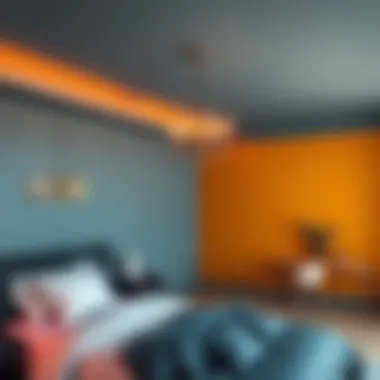
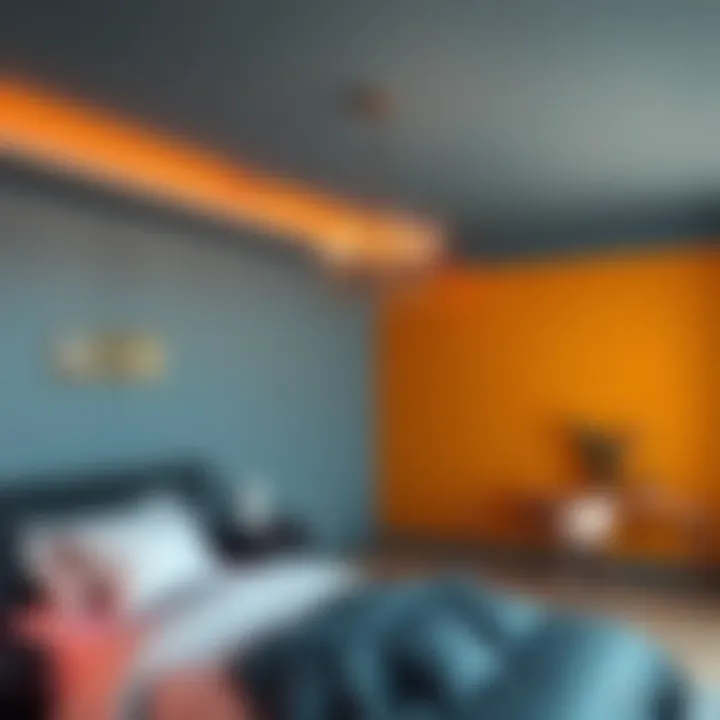
- Teal and White: Fresh and lively, this pair fosters clarity and calmness.
- Mustard Yellow and Gray: The warmth of yellow pops against the coolness of gray, striking a wonderful balance.
- Coral and Navy: This combination brings energy and sophistication. Coral’s warmth matches beautifully with the depth of navy.
The benefits of utilizing vibrant accents are multidimensional. They not only enhance aesthetic appeal but also ensure that the overall space feels alive. An important consideration when applying these colors is to balance vibrant patterns with softer, neutral textiles—cushions, curtains, or rugs—to maintain a fluid visual experience in the room.
High-Contrast Pairings
High-contrast pairings combine opposing colors, creating a dramatic impact and a sense of depth that exhilarates any bedroom atmosphere. Think of the timeless duo of black and white. This classic palette is both contemporary and timeless. When you inject a splash of color into this mix, you amplify the statement made by the high-contrast theme.
Examples of high-contrast combinations that you might consider:
- Black and White with Scarlet Accents: This creates bold visuals; introduce red elements through artwork or decor.
- Charcoal and Vibrant Lime: A deep gray can soften the zingy brightness of lime, making the room pop while still retaining elegance.
- Cream and Royal Blue: This pairing feels luxe—adding gold or brass fixtures can elevate the warmth further.
Before committing to a high-contrast scheme, consider the emotional response you want to evoke. Some colors can energize, while others promote relaxation. Finding that perfect balance ensures the bedroom will remain a peaceful retreat, even when bold colors are present.
"Color is the keyboard, the eye is the hammer, and the soul is the piano with many strings." – Wassily Kandinsky
Ultimately, bold and contemporary combinations allow homeowners to craft spaces that stand out and resonate with their personal narratives. Whether through vibrant accents or impeccably paired contrasts, the journey of exploring colors for your bedroom is both endless and exciting.
Seasonal Trends in Colors
Color in the home is not merely a superficial element; it plays a crucial role in how we perceive and experience our spaces. Seasonal trends in colors are significant, particularly for the bedroom, as they align with our natural rhythms and feelings throughout the year. By tapping into seasonal palettes, individuals can refresh their personal sanctuaries—fostering comfort and harmony, while allowing for personal expression. It’s essential to consider how color affects not only aesthetics but also our moods and emotions.
Incorporating seasonal colors can also enhance the relationship between the interior and nature, bridging the gap between outside landscapes and the comfort of one’s home. Selecting the right hues can evoke feelings that resonate with the changing environment, making spaces resonate with warmth in the colder months or freshness in spring and summer.
Spring and Summer Palettes
As the sun starts to peek through after the grayness of winter, spring and summer palettes typically embrace vibrant hues while also pulling in softer, muted tones. Pastels, soft greens, and gentle blues signify renewal and fresh beginnings. For instance, colors like pale lavender or mint green can breathe life into a bedroom, imparting a sense of calm and tranquility. On the other hand, bolder shades like a bright sunflower yellow or coral can invigorate a space, reflecting the energetic essence of the warmer months.
- Pale Blush Pink: Associated with romance and softness, this color brings a gentle warmth to the room.
- Sky Blue: Represents serenity and spaciousness—perfect for creating a peaceful bedtime environment.
- Fresh Mint: This invigorating green can stimulate creativity and provide a refreshing vibe.
When selecting your spring and summer shades, consider the natural light flooding in through windows. Lighter colors can bounce that light around, creating a bright and airy atmosphere that feels upbeat yet comfortable. Using light curtains can further amplify this brightness, allowing color to play with the ambient light.
Autumnal and Winter Shades
As days shorten and temperatures cool, there's a shift in our color preferences for bedroom spaces. Autumnal and winter palettes often gravitate towards deeper, richer earth tones and muted shades. Think of rustic oranges, dark browns, and joining cozy neutrals like taupe or creamy whites. These colors evoke feelings of warmth and security, making the bedroom a comforting retreat during the colder months.
- Deep Burgundy: This rich shade brings a sense of decadence and warmth, perfect for pairing with cozy textures like velvet.
- Warm Gray: Offers a modern twist on tradition while still being inviting and versatile.
- Forest Green: Reminiscent of the evergreens, this color can create a soothing effect, ideal for peaceful sleep.
Moreover, warmer colors can create an inviting environment that makes your space feel snug and welcoming. It’s a good idea to mix in some textured materials, like blankets or pillows in these shades, which can enhance the color’s warmth and depth, inviting you to hunker down for the season.
Whether you choose to stick with popular seasonal themes or find your own unique blend, it's vital to pay attention to how certain colors influence your feelings throughout a year. Bringing seasonal trends into your bedroom design is a personal journey. Embrace the hues that resonate with your spirit and create a sanctuary that reflects your unique personality and mood.
Room Accents and Accessories
When it comes to designing a bedroom, choosing the right paint color is just one piece of the puzzle. Room accents and accessories play a pivotal role in bringing the whole space together.* They can highlight the primary color scheme, add layers of texture, and introduce personality that is distinctly yours. Every item you choose will impact the overall feel of the room and contribute to its atmosphere.* Therefore, it’s essential to consider how these accessories work harmoniously with your wall and ceiling colors.
Textiles and Fabrics
In the realm of interior design, textiles and fabrics are often the unsung heroes. They have the power to soften hard surfaces and create a sense of warmth that paint alone cannot achieve. Selecting the right fabrics for curtains, bedding, and throw pillows can make a huge impact.
- Layering Textures: Incorporating different textures, such as a soft velvet throw combined with a cotton duvet cover, can create an inviting bedroom environment. This layering adds depth and visual interest, making the space feel more nuanced.
- Color Coordination: Fabrics can also provide an opportunity for color experimentation. Don’t be afraid to stray from your primary wall color. For example, if you've painted your walls a calming sage green, consider adding blush pink or muted gold accents to your bedding or curtains. This combination can evoke a sense of tranquility while keeping things fresh and vibrant.
- Functionality and Comfort: Beyond aesthetics, consider the functionality of your fabrics. Heavier materials might be ideal for insulating warmth during winter months, while lighter fabrics allow for airflow during summer.
Artwork and Decor
Art and decor serve as the cherries on top of your bedroom design sundae. They are vital in defining the vibe of your sanctuary, providing not only visual appeal but also a personal touch. Choosing the right pieces can anchor the color scheme and enhance the emotional warmth of the room.
- Focal Points: Large art pieces or statement decor items, like an oversized painting or an interesting sculpture, can serve as a focal point. Consider how colors in the artwork echo the hues in your paint, creating a seamless blend that draws the eye across the room. A bold abstract painting with splashes of cerulean can work beautifully against neutral taupe walls.
- Gallery Wall Ideas: If you feel adventurous, you might opt for a gallery wall. This technique allows you to combine various artworks, photographs, and decorative objects of different sizes and frames. It gives an opportunity to play with patterns and colors while creating a personal narrative that reflects your journey.
- Final Touches: Don’t underestimate smaller decor items such as table lamps, vases, or decorative trays. These elements should not only complement your main color palette but also reflect your personality. Choose pieces that feel right in your hand, add warmth in your heart, and are a true reflection of who you are.
Ceiling Colors: Beyond White
When it comes to creating a comfortable and unique sanctuary in your bedroom, considering the color of the ceiling is often an overlooked but vital aspect. Most people default to white ceilings, thinking they provide an airy feel and blend with any color scheme. However, breaking away from that white box can propel your bedroom into a realm of creativity and warmth.
Using color on ceilings can set the tone and atmosphere of the entire space. The ceiling, often viewed as the fifth wall, can dramatically influence how a room feels. Depending on the hue, it can create a sense of coziness or open up the space, drawing the eye upward and making the room feel larger. With the right shade, your ceiling can act as a canvas, reflecting personal taste and helping to establish a more cohesive design.
Color Trends for Ceilings
In recent years, there has been a shift toward experimenting with bolder colors and unique finishes for ceilings. Some popular trends include:
- Soft Pastels: Light blush or powder blue can soften the space, making it feel calm and inviting.
- Deep Jewel Tones: Colors like emerald green or sapphire blue evoke richness, creating a sophisticated backdrop for the room.
- Smoky Grays: These hues can modernize a space while keeping it grounded and flexible.
- Contrasting Shades: Pairing a dark ceiling with lighter walls can create a dramatic effect that draws attention to architectural features.
- Metallic Finishes: Subtle golds or silvers can add a touch of luxury and intrigue without overwhelming the space.
Each of these choices can mimic different psychological impacts; for example, dark colors can feel intimate, whereas lighter shades tend to open up the room. Choose wisely based on the mood you wish to cultivate.
Visual Impact of Ceiling Shades
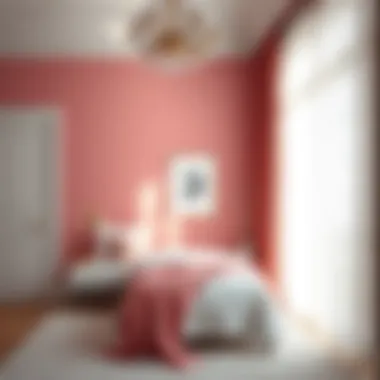
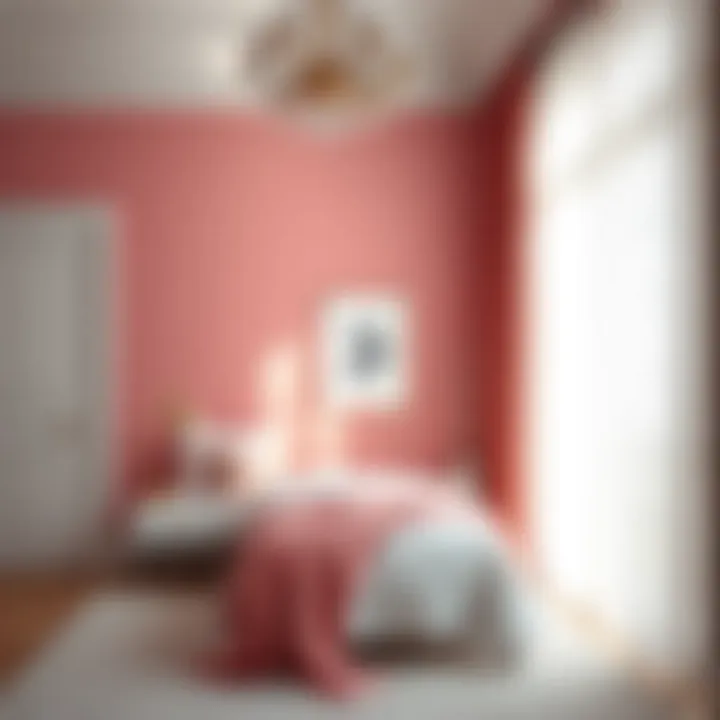
The visual impact of a colored ceiling cannot be overstated. It can transform how we perceive the size and height of a room. If you have low ceilings, light colors can make the ceiling feel higher. Conversely, a darker color may create a cozy, cave-like atmosphere which some may find comforting. Here are several aspects to consider:
- Height Perception: Lighter colors tend to reflect more light, thus giving the illusion of height. Darker colors absorb light, making ceilings appear lower.
- Creating Zones: In an open-plan bedroom, color can help define different areas. For example, a distinct ceiling color can delineate the sleeping area from a reading nook.
- Cohesiveness: Using the same accent color from the walls on the ceiling can bring a space together, creating a welcoming flow. This can unify the overall color scheme and enhance visual harmony.
"Color is an essential element in design; it not only defines spaces but also impacts our feelings. Consider the ceilings as part of your overall color design strategy."
Choosing the right color for your ceiling can be more than a mere aesthetic decision; it can enhance both the functionality and beauty of your bedroom. Delve into the myriad of options available, and don't shy away from experimenting. It's about creating a space that feels like home, reflecting your personality and offering a sense of well-being.
Creating Cohesion in Design
Creating a sense of cohesion in bedroom design is no less than art. This theme weaves together aesthetic unity and emotional harmony. When discussing color combinations for walls and ceilings, considering cohesion transforms a collection of hues into a cohesive masterpiece. A well-thought-out design not only pleases the eyes but also nurtures a feeling of peace and belonging.
Color sets the stage; it can unify disparate elements throughout the home, making transitions smooth and natural. Think of it as the thread that binds a tapestry. When your bedroom color palette extends into adjoining spaces, it creates visual flow. Colors can even echo across different rooms, providing a calming narrative that continues beyond the threshold of each door.
The choice of colors needs careful consideration. If one room boldly sports navy blue, the adjoining space could seamlessly pick a lighter shade of blue or even a color that contains a hint of blue. This thoughtful approach builds a bridge, allowing your spaces to converse without interruption. When making selections, it’s essential to keep in mind the overall theme of your home; traditional, contemporary, or an eclectic mix, stick to a palette that tells your story.
Linking Rooms through Color
Color creates pathways between rooms. It establishes a dialogue that can easily be lost if selected without consideration. Imagine walking from your serene powder blue bedroom into a harmonious greenish-gray hallway, where each step feels like turning the pages of a calming book. The flow enhances movement and continues the narrative you want your home to tell.
- Create a Color Journey: Use soft variations of a primary color. For instance, if your bedroom is egg-shell blue, consider transitioning into soft teal in the hallway.
- Reflect Personal Style: Allow the personality reflected in your bedroom to shine in adjacent rooms. If you prefer a rustic style, exploirng shades of cream leading into terracotta can work well.
- Transitions Aided by Accents: Use furnishings as anchors. Just like in a canvas painting, a piece of furniture in a coordinating color can serve to link rooms cohesively.
This subtle interplay indicates both distinctions and connections, making each space unique yet harmoniously tied. An added benefit is that well-coordinated colors can also improve the perception of size and light, making spaces feel more expansive or cozy, depending on your choices.
Using Color to Define Zones
In open-concept homes, defining zones becomes crucial. Color can act as a powerful tool for creating boundaries while promoting unity. By carefully selecting both bold and subtle shades, physical boundaries blur and intimacy grows. For instance, a gentle lavender can designate a sleep area while a deeper purple or plum defines a reading nook within the same room, helping establish functionality without building visual barriers.
- Use Dividers and Colors: Feature walls painted in distinct colors can serve as a marker for a specific function, subtly guiding how space is utilized.
- Layered Shades: Consider lighter shades for relaxing spaces like bedrooms, while opting for richer tones in more energetic zones such as workspace or play corners.
- Visual Cues with Accessories: Enhance spatial distinction using colored rugs, pillows, or artwork that harmonize with chosen hues, providing tangible markers that define different zones.
"Color is the keyboard, the eyes are the harmonies, the soul is the piano with many strings."
Using these ideas can set up a space that tells stories, encourages relaxation, and expresses who you are.
Practical Considerations
When it comes to redesigning a bedroom, practical considerations are not just an afterthought; they are essential pillars that guide decisions. Getting the right color combinations for walls and ceilings is one thing, but understanding how to approach this task can significantly affect both the outcome and your peace of mind during the process. Without a solid grounding in practical applications, your color choices may turn into the proverbial double-edged sword.
First and foremost, it’s key to think about the physical space at hand. Is the room bathed in natural light? Does it feel spacious or cramped? Each of these factors can help you decide which color will not only look good but also feel right. Colors can trick the mind—light shades may expand the illusion of space, while dark colors can make you feel more cocooned and cozy.
"Choosing the right color is like picking a good pair of shoes; it must fit the space and the mood you’re aiming to create."
Another element to grasp is the longevity of your choices. While some may opt for trends, it's wise to balance trendy colors with those that you feel genuinely resonate with you. Trends fade faster than a summer tan, but a color that compliments your personal style will stand the test of time.
Testing Color Samples
The practical step of testing color samples can save you from a world of heartache. Don’t just grab a swatch and think you can see how it looks from that little piece of paper. Every paint brand often has its unique reflectivity and texture, causing colors to behave differently on walls versus in swatches. Start by purchasing small sample pots from brands you trust, like Sherwin-Williams or Benjamin Moore. Here's how to conduct a thorough test:
- Apply on Various Surfaces: Different materials reflect light differently. Test your samples on drywall, wood, or any other surface you plan to paint.
- Observe in Different Lighting: Colors can appear dramatically different under various lighting conditions. Examine the samples during day and night to note how they shift.
- Live with It: Leave swatches up for a few days. This will help you get a feel for how the color impacts your mood over time.
Understanding Paint Finishes
Once you’re on board with the colors, understanding paint finishes is the next crucial piece. "Paint finish" isn’t just about the sheen; it affects how that color looks, how it wears over time, and even how it cleans.
- Matte Finish: Offers a soft touch and is great for hiding imperfections. Ideal for ceilings or formal areas where minimal shine is preferred.
- Eggshell Finish: A bit more durable than matte, it strikes a good balance. Great for living spaces that see a lot of activity.
- Satin Finish: Has a slight sheen, perfect for kitchens or kids' rooms. It’s relatively easy to clean, but may highlight imperfections.
- Semi-Gloss: The heavy-duty champion among finishes. Ideal for areas requiring durability, like trim and moldings.
- High-Gloss: For those that want maximum shine. While it's striking, keep in mind, it shows every flaw. Use wisely.
Choosing the right finish along with the color can transform not just the look but the usability of a room. With practical considerations sorted, your journey toward a beautifully-designed bedroom can progress with confidence.
End and Final Thoughts
In the journey through color combinations for bedroom walls and ceilings, it's vital to recognize not just the aesthetic appeal but the emotional impact colors can have on our lives. The bedroom is more than a physical space; it’s a sanctuary where we unwind, recharge, and express personal tastes. Understanding how color influences mood can significantly elevate the design process.
Summarizing Key Insights
As we reviewed various aspects of color choices, several key points emerged:
- Color Psychology: Different hues evoke different feelings. For instance, blue often brings calmness, while yellow may energize an environment.
- Natural Light Consideration: The amount and quality of light can drastically change the perception of wall colors. Testing paint samples under various conditions is essential before making a final choice.
- Cohesion and Flow: Linking rooms through color can create a sense of unity in a home, while defining zones can improve spatial dynamics.
- Accents and Accessories: Incorporating textiles and art can complement wall colors and add depth without overwhelming the space.
These insights highlight that color selection is not merely a choice of paint but a means of enhancing the overall atmosphere of a home. It’s about blending personal tastes with practical considerations, ensuring each decision contributes positively to daily life.
Encouragement for Personal Expression
Color in the bedroom serves as a canvas for personal expression. Perhaps you find solace in a muted palette or get inspired by bold contrasts. Whatever your preference, ensuring your wall colors resonate with your personality is paramount.
- Don’t hesitate to break tradition. Mixing textures with different color schemes can create a unique flair that speaks to who you are.
- Experiment with seasonal changes as well. Shifting hues per season—soft pastels in spring, earthy tones in autumn—can rejuvenate your space and reflect the outside world.
Remember, your bedroom reflects not only your style but your state of mind. By making conscious color choices, you can cultivate a space that truly feels like home.
Important Reminder:
"Color is not just what you see, it’s how you feel."
For further insights on color theory and bedroom design tips, consider checking resources such as Wikipedia on Color Psychology and Britannica on Color Theory.
Find inspiration and community discussions about home decor on platforms such as Reddit and Facebook groups.



